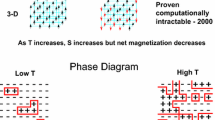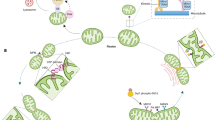...[E]stimation of mutual information and channel capacity [of cellular signals] from experimental data is a nontrivial challenge.
— Suderman et al. (2017)
Abstract
Mitochondrial dysfunction underlies a vast array of chronic disorders across the life span. The asymptotic limit theorems of information and control theories, supplemented by symmetry-breaking phase transition arguments adapted from physical theory, give deep insight into canonical mechanisms of cognition and regulation associated with such dysfunction. The probability models studied here can provide a foundation for the development of statistical tools useful in clinical and public health address of those disorders.








Similar content being viewed by others
References
Appleby J, Mao X, Rodkina A (2008) Stabilization and destabilization of nonlinear differential equations by noise. IEEE Trans Autom Control 53:126–132
Atlan H, Cohen I (1998) Immune information, self-organization, and meaning. Int Immunol 10:711–717
Bazil JN, Buzzard GT, Rundell AE (2020) Modeling mitochondrial bioenergetics with integrated volume dynamics. PLoS Comput Biol 6:e1000632
Boyd S (2004) Convex optimization. Cambridge University Press, New York
Brah F, Zaidi A, Louveaux J, Vandendorpe L (2011) On the Lambert-W function for constrained resource allocation in cooperative networks. EURASIP J Wirel Commun Netw. https://jwcn-eurasipjournals.springeropen.com/articles/10.1186/1687-1499-2011-19
Brown R (1992) Out of line. R Inst Proc 64:207–243
Casas-Vazquez J, Jou D (2003) Temperature in non-equilibrium states: a review of open problems and current proposals. Rep Progr Phys 66:1937–2023
Cayron C (2006) Groupoid of orientational variants. Acta Crystalogr Sect A A62:21040
Champagnat N, Ferriere R, Meleard S (2006) Unifying evolutionary dynamics: from individual stochastic process to macroscopic models. Theor Popu Biol 69:297–321
Cover T, Thomas J (2006) Elements of information theory, 2nd edn. Wiley, New York
de Groot S, Mazur P (1984) Nonequilibrium thermodynamics. Dover, New York
Dembo A, Zeitouni O (1998) Large deviations and applications, 2nd edn. Springer, New York
Feynman R (2000) Lectures on computation. Westview Press, New York
Golubitsky M, Stewart I (2006) Nonlinear dynamics and networks: the groupoid formalism. Bull Am Math Soc 43:305–364
Gould S, Lewontin R (1979) The spandrels of San Marco and the Panglossian paradigm: a critique of the adaptationist programme. Proc R Soc Lond B 205:581–98
Jin H, Xu Z, Zhou X (2008) A convex stochastic optimization problem arising from portfolio selection. Math Finan 18:171–183
Khinchin A (1957) Mathematical foundations of information theory. Dover Publications, New York
Laidler K (1987) Chemical kinetics, 3rd edn. Harper and Row, New York
Maturana HR, Varela F (1980) Autopoiesis and cognition: the realization of the living. Reidel, Dordrecht
Nair G, Fagnani F, Zampieri S, Evans R (2007) Feedback control under data rate constraints: an overview. Proc IEEEE 95:108–137
Nocedal J, Wright S (2006) Numerical optimization, 2nd edn. Springer, New York
Pettini M (2007) Geometry and topology in Hamiltonian dynamics and statistical mechanics. Springer, New York
Picard M (2015) Mitochondrial synapses: intracellular communication and signal integration. Trends Neurosci 38:468–474
Picard M, McEwen B (2018) Psychosocial stress and mitochondria: a conceptual framework. Psychosom Med 80:126–140
Picard M, McEwan B, Epel E, Sandi C (2018) An energetic view of stress: focus on mitochondria. Front Neuroendocrinol 49:72–85
Picard M, Trumpff C, Burelle Y (2019) Mitochondrial psychobiology: foundations and applications. Curr Opin Behav Sci 28:142–151
Pielou EC (1977) Mathematical ecology. Wiley, New York
Protter P (2005) Stochastic integration and differential equations: a new approach, 2nd edn. Springer, New York
Sonnino G, Evslin J, Sonnino A, Steinbrecher G, Tirapegui E (2016) Symmetry group and group representations associated with the thermodynamic covariance principle. Phys Rev E 94:042103
Stewart I (2017) Spontaneous symmetry-breaking in a newtwok model for quadruped locomotion. Int J Bifurcat Chaos 27(14):1730049
Suderman R, Bachman J, Smith A, Sorger P, Deeds E (2017) Fundamental trade-offs between information flow in single cells and cellular populations. Proc Natl Acad Sci 114:5755–5760
Sukhorukov V, Dikov D, Reichert A, Meyer-Hermann M (2012) Emergence of the mitochondrial reticulum from fission and fusion dynamics. PLOS Comput Biol 8(10):e1002745. https://doi.org/10.1371/journal.pcbi.1002745
Sukhorukov V, Meyer-Hermann M (2015) Structural heterogeniety of mitochondria induced by the microtubule cytoskeleton. Sci Rep 5:13924. https://doi.org/10.1038/srep13924
Vo TD, Lee WP, Palsson BO (2007) Systems analysis of energy metabolism elucidates the affected respiratory chain complex in Leigh’s syndrome. Mol Genet Metab 91:15–22
Wallace R (2005) Consciousness: a mathematical treatment of the global neuronal workspace model. Springer, New York
Wallace R (2012a) Consciousness, crosstalk, and the mereological fallacy: an evolutionary perspective. Phys Life Rev 9:426–453
Wallace R (2012b) Extending Tlusty’s rate distortion index theorem method to the glycome: Do even ‘low level’ biochemical phenomena require sophisticated cognitive paradigms? BioSystems 107:145–152
Walace R (2015) An information approach to mitochondrial dysfunction: extending Swerdlow’s hypothesis. World Scientific, Singapore
Wallace R (2017) Computational psychiatry: a systems biology approach to the epigenetics of mental disorders. Springer, New York
Wallace R (2018a) Culture and the trajectories of developmental pathology: insights from control and information theories. Acta Biotheor 66:79–112
Wallace R (2018b) New statistical models of nonergodic cognitive systems and their pathologies. J Theor Biol 436:72–78
Wallace R (2020a) On the variety of cognitive temperatures and their symmetry-breaking dynamics. Acta Biotheor. https://doi.org/10.1007/s10441-019-09375-7
Wallace R (2020b) Cognitive dynamics on Clausewitz landscapes: the control and directed evolution of organized conflict. Springer, New York
Weinstein A (1996) Groupoids: unifying internal and external symmetry. Notices Am Math Assoc 43:744–752
Wu F, Yang F, Vinnakota KC, Beard DA (2007) Computer modeling of mitochondrial tricarboxylic acid cycle, oxidative phosphorylation, metabolite transport, and electrophysiology. J Biol Chem 282:24525–24537
Zamponi N, Zamponi E, Cannas S, Billoni O, Helguera P, Chialvo D (2018) Mitochondrial network complexity emerges from fission/fusion dynamics. Sci Rep 8:363. https://doi.org/10.1038/s41598-017-18351-5
Acknowledgements
The author thanks Dr. D.N. Wallace—an actual biologist—for useful comments and suggestions, and the editor and reviewers for perceptive insights and hard work.
Author information
Authors and Affiliations
Corresponding author
Ethics declarations
Conflict of interest
The authors declare no conflict of interest.
Additional information
Publisher's Note
Springer Nature remains neutral with regard to jurisdictional claims in published maps and institutional affiliations.
Rights and permissions
About this article
Cite this article
Wallace, R. Fractured Symmetries: Information and Control Theory Perspectives on Mitochondrial Dysfunction. Acta Biotheor 69, 277–301 (2021). https://doi.org/10.1007/s10441-020-09387-8
Received:
Accepted:
Published:
Issue Date:
DOI: https://doi.org/10.1007/s10441-020-09387-8




